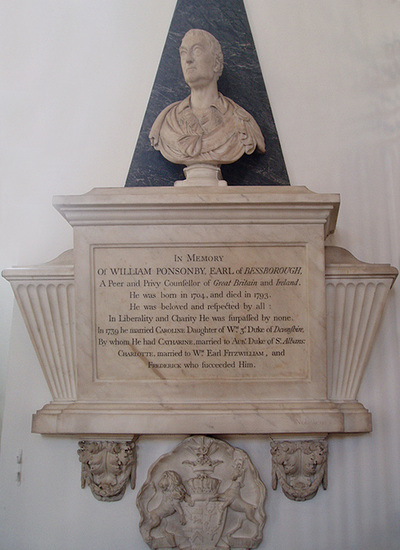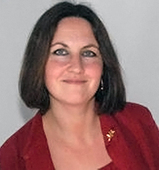R.W.Bro. the Hon. William Ponsonby
(later 2nd Earl of Bessborough) Senior Grand Warden 1731
|
We have very little information on the early life of William Ponsonby, Earl of Bessborough. He was born in 1704, the eldest surviving son of Brabazon Ponsonby (2nd Lord Viscount Duncannon), and his first wife, Sarah Margetson. His place of birth is never stated in the records, though we can assume he was born at the family seat of Bessborough in County Kilkenny, an estate bestowed upon his grandfather, Sir John Ponsonby, in recognition of his services to Cromwell. |
R.W.Bro. the Hon. William Ponsonby
(later 2nd Earl of Bessborough) (1704-11th March, 1793) |
In politics, he was returned as MP for Newtownards, County Down, from 1725-1727, for Kilkenny from 1727-58, for the town of Derby from 1742-54, for Saltash from 1754-56 and for Harwich from 1756-58. He had to vacate his seats when he succeeded his father, Brabazon, as 2nd Earl of Bessborough, in 1758, inheriting his estates in Ireland (notably in Counties Kilkenny and Carlow) and in England.
It is not known when William Ponsonby became involved with Freemasonry – he may have been involved in the meeting of Grand Lodge in 1725 (at the time he would have been 21 years of age) but if he was not at that event he was certainly involved with the “revival”, as he is specifically mentioned in “The Dublin Weekly Journal” of 13th March, 1730/31 as the Master of “a Lodge of Free-Masons....held at the Yellow Lyon in Warborough's-street” on the 6th March, 1731. This Lodge was a private Lodge, not the Grand Lodge. The meeting was attended by the then Grand Master, the Earl of Rosse and “the Lord Kingston, late Grand Master of England”. The recounting of this meeting was the first official sign of life of the Grand Lodge since the 1725 report of the appointment of the Earl of Rosse as Grand Master.
Lord Kingston was, subsequently, on the 6th April, 1731, elected “Grand Master for the ensuing year for the kingdom of Ireland”. The Hon. William Ponsonby was appointed Senior Grand Warden for the year 1731.
Ponsonby left Ireland on his “Grand Tour” to Europe at the end of 1736 and it clear from contemporary newspaper reports contained in Faulkner's Dublin Journal, dated 30th August, 1737 and 20th September, 1737 that he was in the company of Charles Sackville, the Earl of Middlesex, who it is accepted constituted a Lodge in Florence in 1733 and is famous for the “Sackville Jewel”.
When William returned from his travels at the end of 1738, he seems to have taken up permanent residence in England. The following year was a very momentous one for this young nobleman - on 5th July, 1739 he married Lady Caroline Cavendish, eldest daughter of the 3rd Duke of Devonshire (then Lord Lieutenant of Ireland). Two years later, in the summer of 1741, his father-in-law offered him the appointment as his Chief Secretary (which he accepted), as well as recommending him for a place on the Irish Privy Council.
It is not known when William Ponsonby became involved with Freemasonry – he may have been involved in the meeting of Grand Lodge in 1725 (at the time he would have been 21 years of age) but if he was not at that event he was certainly involved with the “revival”, as he is specifically mentioned in “The Dublin Weekly Journal” of 13th March, 1730/31 as the Master of “a Lodge of Free-Masons....held at the Yellow Lyon in Warborough's-street” on the 6th March, 1731. This Lodge was a private Lodge, not the Grand Lodge. The meeting was attended by the then Grand Master, the Earl of Rosse and “the Lord Kingston, late Grand Master of England”. The recounting of this meeting was the first official sign of life of the Grand Lodge since the 1725 report of the appointment of the Earl of Rosse as Grand Master.
Lord Kingston was, subsequently, on the 6th April, 1731, elected “Grand Master for the ensuing year for the kingdom of Ireland”. The Hon. William Ponsonby was appointed Senior Grand Warden for the year 1731.
Ponsonby left Ireland on his “Grand Tour” to Europe at the end of 1736 and it clear from contemporary newspaper reports contained in Faulkner's Dublin Journal, dated 30th August, 1737 and 20th September, 1737 that he was in the company of Charles Sackville, the Earl of Middlesex, who it is accepted constituted a Lodge in Florence in 1733 and is famous for the “Sackville Jewel”.
When William returned from his travels at the end of 1738, he seems to have taken up permanent residence in England. The following year was a very momentous one for this young nobleman - on 5th July, 1739 he married Lady Caroline Cavendish, eldest daughter of the 3rd Duke of Devonshire (then Lord Lieutenant of Ireland). Two years later, in the summer of 1741, his father-in-law offered him the appointment as his Chief Secretary (which he accepted), as well as recommending him for a place on the Irish Privy Council.
A more comprehensive account of the life of William Ponsonby can be accessed by the following link -
The Classical Taste of William Ponsonby, 2nd Earl of Bessborough (1704-93) - the Author of this paper is Dr Rachel Finnegan of the Waterford Institute of Technology [see Footnote].
The paper was published in the Journal of the Irish Georgian Society (Volume VIII, 2005) pages 12-43.
Footnote
|
.
Dr Rachel Finnegan
|
Dr Rachel Finnegan read Classical Philology at Trinity College Dublin & NUI Maynooth, spent two years at the British School of Archaeology at Athens and has been Lecturer in Tourism & Heritage Studies in the School of Humanities, Waterford Institute of Technology, Ireland since 1994, and is Programme Leader for the M.A. in Arts & Heritage Management in the Department of Creative & Performing Arts.
Her new edition of Richard Twiss's A Tour of Ireland in 1775 was published in 2008 by University College Dublin Press; and Volumes 1, 2 & 3 of her three-volume edition of Richard Pococke's travel correspondence (Letters from Abroad) were published in 2011, 2012 and 2013 respectively. |
Further details of her above mentioned publications can be found at her website: www.pocockepress.com
I would highly recommend a visit.
I would highly recommend a visit.




